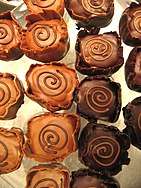Bonbon
A bonbon is a small chocolate confection. They are usually filled with liqueur or other sweet ingredients, and sold wrapped in coloured foil.[1]
 Dutch bonbons | |
| Alternative names | Bon-bon |
|---|---|
| Type | Confectionery |
| Place of origin | France |
Ingredients
In France, bonbons are usually made with a fruit centre, and may contain brittle, nougat, dragée, or caramel. In the Western world, bonbons are usually also small candies, but can vary by region in their ingredients, flavours, and shape.[2]
Other types of fillings include butterscotch, fondant, fudge, ganache, gianduja, marzipan, praline, and truffle.[3]
Etymology and history
The word "bonbon" arose from the reduplication of the word bon, meaning "good" in the French language. Its use originated in the seventeenth century within the French royal court, and spread to other European countries by the eighteenth century. Bonbons began to be served in ornate containers by the middle of the eighteenth century, which would be given as gifts at festivals and on holidays such as New Year's Day.[2][4]
Inspired by bonbons, Johann Strauss II wrote the waltz Wiener Bonbons in 1866. Its title page shows the composition's name in the form of twisted bonbon wrappers.[2]
Legislation
According to French law, a chocolate candy or bonbon de chocolat must be at least 25% chocolate and can come in several forms:
- a bite-sized chocolate;
- an arrangement of different chocolates;
- a mixture of chocolate and other edible ingredients.[5]
Specifically in the United States, the phrase "Bon Bon" can also refer to The Hershey Company's trademarked name of a frozen confection made from vanilla ice cream and covered in chocolate.[2]
See also
References
- "cioccolatino in Vocabolario". Treccani (in Italian).
- Goldstein, Darra; Krondl, Michael; Heinzelmann, Ursula; Mason, Laura; Quinzio, Geraldine & Rath, Eric, eds. (2015). The Oxford companion to sugar and sweets. Oxford University Press. p. 69. ISBN 9780199313396.
- Coady, Chantal (1998). "Estilos de chocolate". O Guia do Chocolate (in Portuguese). Livros e Livros. pp. 23–29. ISBN 9789728418335.
- "What Is A Bon Bon?". South 'n France Bon Bons. 29 March 2017. Archived from the original on 8 August 2017. Retrieved 30 April 2020.
- "Décret n°76-692 du 13 juillet 1976 pris pour l'application de la loi du 1er août 1905 sur la répression des fraudes dans la vente des marchandises et des falsifications des denrées alimentaires, en ce qui concerne les produits de cacao et de chocolat destinés à l'alimentation humaine - Article Annexe". legifrance.gouv.fr (in French).